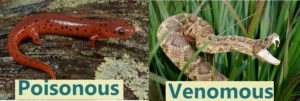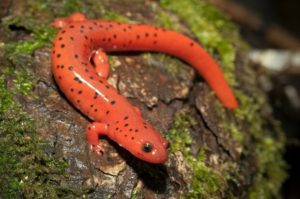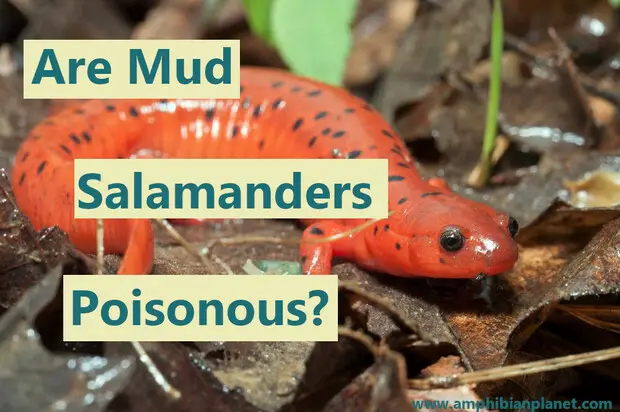Mud salamanders are beautiful amphibians found across the Southeastern united states. These salamanders are known for their reddish-brown coloration with well-separated black spots on the back and sides.
Younger mud salamanders are usually brightly colored and can be difficult to distinguish from red salamanders. Since red salamanders are somewhat poisonous, you may be wondering if their look-alike also possesses a toxin.
Mud salamanders are mildly poisonous. They have glands along the backside of their bodies that produce a toxic secretion as a defense against predators. This secretion is mildly toxic and may irritate or sicken small animals, but is of no major threat to humans.
The only real danger mud salamanders pose is that, like other amphibians, they can be carriers of salmonella and other harmful bacteria which can be transmitted to humans if proper hygiene is not practiced.
Why Mud Salamanders Have a Toxin
Mud salamanders are known for being very secretive and their murky habitats mean they can be difficult to find. They usually never wander too far from their burrows, and when threatened, will run back to their burrows to hide.
However, sometimes they wander far away from their burrows, and as soft-bodied slow-moving creatures, they become a prime target for many predators. This means they need to defend themselves.
The first way a mud salamander defends itself is by assuming a defensive posture where it tucks its head against its body and rears up its hind legs and tail, balancing most of its weight on its front legs. This maneuver makes the salamander appear larger than it is and intimidates some predators.
In addition to the defensive posture, mud salamanders are also capable of secreting a skin toxin along the backside of their body. This toxin irritates any predator that tries to eat a mud salamander.
Mud Salamanders Are Only Mildly Poisonous
Since the toxin is only mild, mud salamanders are still preyed on by some predators, most commonly garter snakes.
That being said, it is important to note that there is a difference between a poisonous animal and a venomous one.
As a general guide,
- Venomous animals will actively inject their toxins, usually via bites or stings.
- Poisonous animals on the other hand deliver their toxins more passively, usually by secreting the toxin on their skin, which is then absorbed by people (or animals) who have contact with it.

Mud salamanders cannot inject their skin secretions, they deliver their toxin by secreting it on their skin. This means they are poisonous but not venomous.
Bright Coloration May Be a Mimic of the More Toxic Eastern Newt

In nature, many toxic animals advertise their toxicity by displaying bright or contrasting colors. This is called “warning coloration” and acts as a defense against predators. Think of it like holding up a huge sign that says “back off I am poisonous!”
No one wants to eat a salamander that could poison them or make them sick.
In the case of mud salamanders, their bright colors may act as a warning that they possess a toxin. However, since mud salamanders are not very toxic, it has been theorized that their coloration developed to partially imitate the highly toxic red-eft stage of the eastern newt.

Predators that come across the mud salamander may fail to distinguish it from the red-eft and avoid eating it. The fact that the mud salamander is also poisonous in itself may help reinforce avoidance behaviors in some predators.
Are Mud Salamanders Dangerous to Humans?
Mud salamanders are usually harmless to humans. While they are poisonous, the toxin they secrete is not potent enough to be of any serious harm to humans. However, it can cause irritation or discomfort but only if you somehow absorb it into your body.
This can happen when you handle a mud salamander, then touch your eyes, nose, or mouth before first washing your hands. This would enable to toxins of the salamander to be absorbed into your body and most likely lead to irritation or discomfort at the point of contact.
Amphibians Can Carry Salmonella
Like most amphibians, mud salamanders can harbor salmonella bacteria in their bodies and pass them off in their waste. The bacteria usually do not affect the salamander but can cause serious illness in any humans who are exposed to them.

Humans can be exposed to salmonella by touching the salamander, its waste, or anything the salamander came in contact with.
Exposure to salmonella can cause an infection called Salmonellosis which although usually non-life-threatening, can be fatal to humans.
For this reason, it is advisable to avoid handling salamanders unless when necessary. Even though salamander might not be very toxic, the bacteria it potentially carries can cause significant harm.
Are Mud Salamanders Dangerous to Pets?
Mud salamanders are only mildly poisonous so it is unlikely they will be a major threat to dogs or any other household pets. A dog that eats a mud salamander may drool or get sick, but the toxin will most likely not be lethal.
Also, salamanders can carry many parasites in their bodies. If a dog or cat were to eat a salamander, it could consume parasites and develop a parasitic infection.
For this reason, it is not a good idea to let your pets get too close to any salamanders. Be it wild salamanders, or pet salamanders you may have at home.
Keep your pet salamanders in a secure enclosure so they do not come into contact with any of your other pets.
How to Safely Handle a Mud Salamander
Like all amphibians, mud salamanders have permeable skin meaning they can absorb oxygen and water through their skin. However, it also means that substances such as lotions, repellents, or perfumes that might be on your hands can penetrate their skin.
Whatever is on your hands could end up inside of their body. For this reason, it is not a good idea to handle salamanders.
However, if you ever decide to handle a salamander, you should make sure that your hands are very clean. Not just clean from dirt but washed off thoroughly so that no residue of soap or any other substances remain on your hands.
But even then, it is advisable to keep your salamander handling to a minimum. Handling amphibians can cause them unwanted stress so it’s probably a good idea to leave them alone.
After handling salamanders, wash your hands with anti-bacterial soap to disinfect yourself from any bacteria (or toxin) you may have picked up from the salamander. Before washing your hands, do not touch your face or put anything in your mouth.
Final Thoughts
Mud salamanders are beautiful salamanders that are, for the most part, harmless to humans. While they do secrete a toxin, it is unlikely to cause any problems if you take a few safety precautions.
With proper care and hygiene, mud salamanders can be totally harmless creatures.


